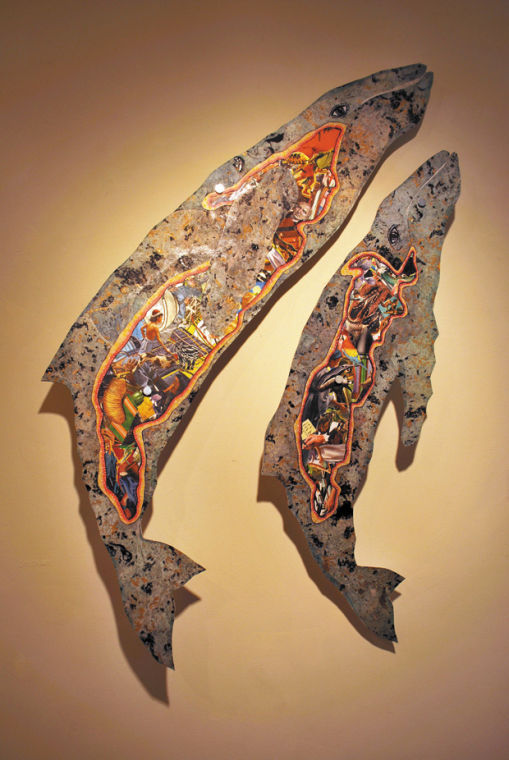Myth and storytelling abound in St. Louis Artists’ Guild exhibit
Published July 17, 2013
Sarah Bernstein’s new exhibition at the St. Louis Artists’ Guild is comprised of monoprints with text and found images as it explores the artist’s interests in myth, communication, storytelling, and Slavic culture.
Bernstein is the 2013 Printmaking Artist-in-Residence at the Artists’ Guild. She grew up in Kentucky and came to St. Louis seven years ago to attend Washington University where she earned a bachelor’s in fine arts in printmaking.
Much of the Artists’ Guild exhibition centers on myth, so it’s fitting that a personal mythology surrounds Bernstein’s own artistic beginnings. “My sister says she told me I was going to be an artist when I was in kindergarten and painted a watercolor of a goldfinch,” says Bernstein, 26. “I always liked to draw and my parents supported my interest.”
Creativity abounds in Bernstein’s family (her sister is now a writer). When the sisters were children, their father would tell them stories, which he turned into sagas.
Stories and Bernstein’s Slavic heritage perform vital roles in her art. In collaboration with a storyteller, Bernstein studied traditional Slavic folktales whose characters, such as Baba Yaga (a female supernatural being with both positive and negative attributes) and a Domovoi (a house spirit), she borrowed in order to create her own stories.
“The storyteller and I worked with the character of Baba Yaga in her true essence as the ‘wise woman’ archetype, rather than her more common depiction as a villain,” Bernstein explains. “I felt many of the characters we examined were the embodiment of archetypes found in stories and many cultures. They could easily be given the ‘stage’ of a contemporary context.”
The traditional, the contemporary, and the personal come together in Bernstein’s pieces, which merge contemporary imagery with elements of Slavic folklore. “This combination visually conveys a sense of deeply personal mythos,” Bernstein says. “It is my way of both belonging to the tradition of folktale-tellers and making art that is relevant to my life, my challenges, my joys and sorrows.”
Bernstein chooses to work with some unexpected mythical subjects. She likes whales and the myths that surround them; two striking pieces in the show include them. One piece, entitled “The Great Listening,” depicts a menstruating female figure crouched on the back of a whale whose skeleton is visible beneath its form. The whale floats calmly on the ocean’s surface under a starry sky. At first glance, the title’s meaning seems to have nothing to do with the imagery, but this is Bernstein’s intention. She deliberately selects titles that appear different from the subject matter.
The menstruating woman takes the central role here, using images of blood in different ways – blood from violence and blood from menstruation. “People seem more comfortable with blood shed through violence than with period blood, even though this kind of bleeding isn’t a sign of crisis,” Bernstein says. “I see menstruation as a metaphor of letting go of something that was created but not used, and yet will be regenerated.”
Bernstein says the girl on the whale in the ocean symbolizes the desire for stillness in a busy world. “There’s a vast sense of solitude in this piece, of coming to terms with things.” The second piece, “Whales Who Swallowed the World I and II,” comprises two cutouts of gray whales on which Bernstein pasted images (from children’s encyclopedias) of people and animals.
Another important theme in Bernstein’s art is communication. Her work explores different ways to communicate as well as problems with our interactions, such often saying things we don’t mean. “My pieces are also similar to ways in which a story is told. You can read a story, hear it, or depict it with images,” she says. “There are words, images, and the piece as a whole. Sometimes the words say what the image doesn’t; sometimes the image says what the words don’t.”
The title of the show encapsulates the importance of myth and storytelling. Bernstein explains, “‘The Heart’s Epic Schlep’ refers to a mythical and larger-than-life sense of going through a transformation. We all go through things like birth, first love, parents’ deaths and subsequent loves — all the ups and downs of life. The word epic refers to a grand story. I love the word schlep because it overemphasizes the burden, the drama, of carrying around our stories and emotional issues.”















